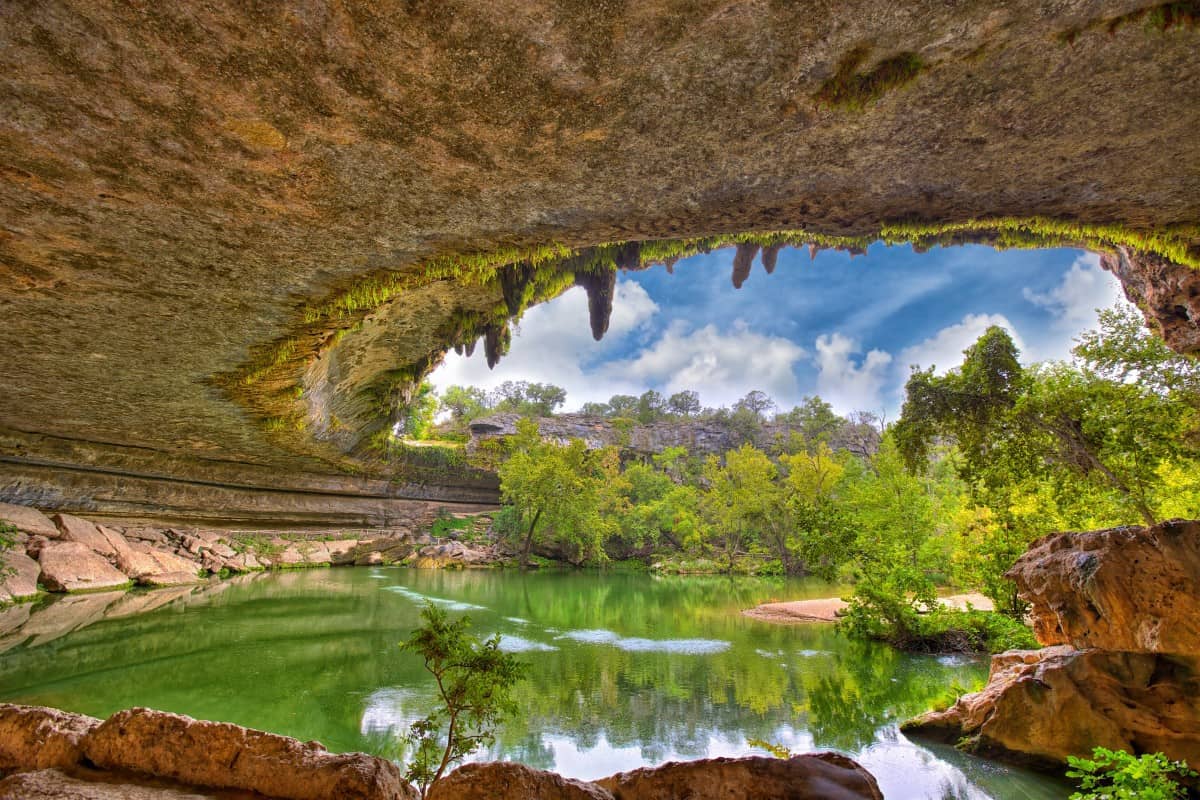Caves have fascinated people for generations, but just how are caves formed? There is something unique and exciting about caves. Prehistoric people used them for shelter, safety, and ceremony. Today, people visit them in droves, exploring their secrets. You may be wondering how these mysterious geologic formations were made.
How are caves formed? Most commonly, a cave is formed when rainwater collects underground. Over thousands or even millions of years, the small amount of acid in the water eats away at the surrounding rock. As the rock dissolves, a cave passage is formed.
You may be wondering how something as harmless as water could dissolve rock. I was intrigued by this question and also wondered about some of the less common ways caves are formed. Here is what I discovered.
Different Ways Caves are Formed
Caves can be formed in a variety of ways, including:
- Rainwater
- Wind erosion
- Volcanos
- Sand erosion
Most caves are formed by rainwater. Rainwater contains a small amount of weak acid called carbonic acid. It may be weak, but it is strong enough to dissolve rock – particularly a specific kind of rock called limestone.
Limestone is made from the shells of dead sea creatures, which have been pressed together over millions of years to form layers of rock. The reason caves are often made of limestone is that it dissolves easily, even in the weakest acid. These types of caves are called solutional caves, and are the most common type.
If you’re interested in getting into caving, be sure to check out my Beginners Guide and recommended gear section.
Types of Caves
The most common type of cave is formed when limestone interacts with acidic rainwater. This is called a solutional cave. However, there are other, less common cave types that exist in specific places. These include:
- Glacier caves
- Erosional caves
- Sea caves
- Lava caves
Glacier Caves
Glacier caves are sometimes called ice caves, probably because that’s what they are made of. Instead of rock, ice is melted away to form a cavern. Melting ice and flowing water carves away at the glacier ice. What’s left behind is an empty space, a cave within a glacier.
Glacier caves don’t last nearly as long as caves made of rock. Glaciers may seem to stand still, but they are actually moving very slowly. The constant, slow movement causes the ice surrounding a glacier cave to fracture – and before you know it, the cave collapses.
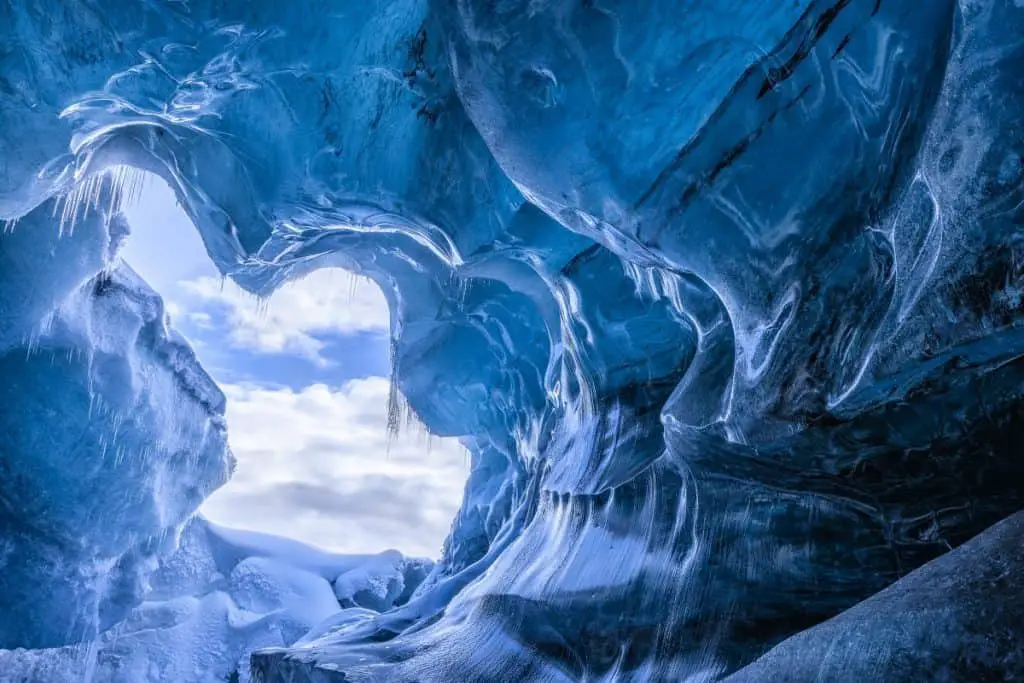
Erosional Caves
Erosional caves may sound just like solutional limestone caves, and in essence, they are – with one major difference. Instead of being formed by acidic water slowly eating away at the rock, erosional caves are carved out by a flowing stream of water. The water carries small rocks and sand. These are capable of eroding much harder rock than limestone. Erosional caves can be formed in even the hardest of rock, such as granite.
There are also erosional caves formed by the wind. That’s right, wind carrying particles of sand can whip around a cliff face, eventually carving a hole in the rock. The rock, in this case, would be a very soft sandstone, so these types of erosional caves can form fairly quickly – and disappear just as fast.
Sea Caves
Sea caves are another type of cave found around the world. As the name implies, sea caves are formed by the eroding action of waves pounding against soft rock such as sandstone. The erosion can occur either above or below the waterline. Just like wind action in the formation of erosional caves, the grinding force of salt water is enough to wear away the rock.
Interestingly, some sea caves can be found inland too! This is because, at one point, that part of the world was closer to the shoreline. Over millions of years, the shoreline shrank back, leaving behind a cave carved in the sandstone.
Sea caves also tend to have a short shelf-life. Constantly battered by sand-filled waves, sea caves often collapse, sometimes leaving a large sinkhole in their place. I used to live by a famous sea cave and over the course of a few years, the cave walls fell into the sea. Waves quickly eroded the sand away.
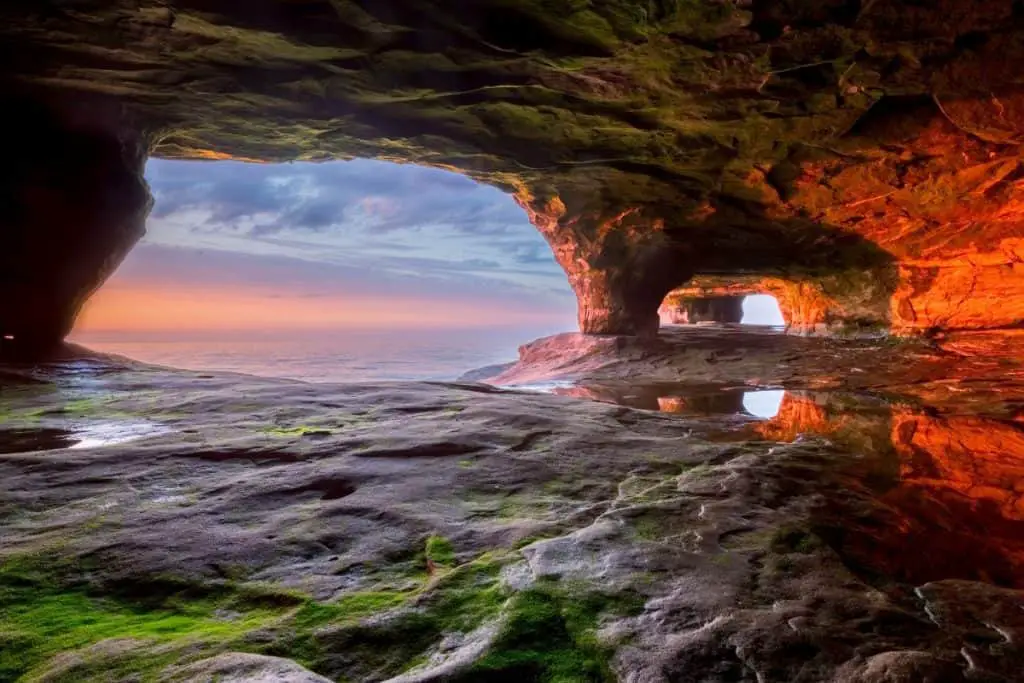
Lava Caves
Lava caves are unique because they aren’t formed by carving away at the rock but are formed right along with the rock. As molten hot lava flows out of the earth, it cools. The cooled lava becomes hard – it is now rock. Meanwhile, a flow of lava may continue under the cooled rock. Once it passes through, a cave is left behind.
Lava caves are almost always tube-shaped. They are sometimes called lava tubes. Many lava caves or tubes can be found in Hawaii, a place famous for its constantly active volcanoes. Lava tubes are also out of this world – literally. Other planets, and even the moon, have formations of lava caves. This is because no water is required in making lava caves, only molten rock.
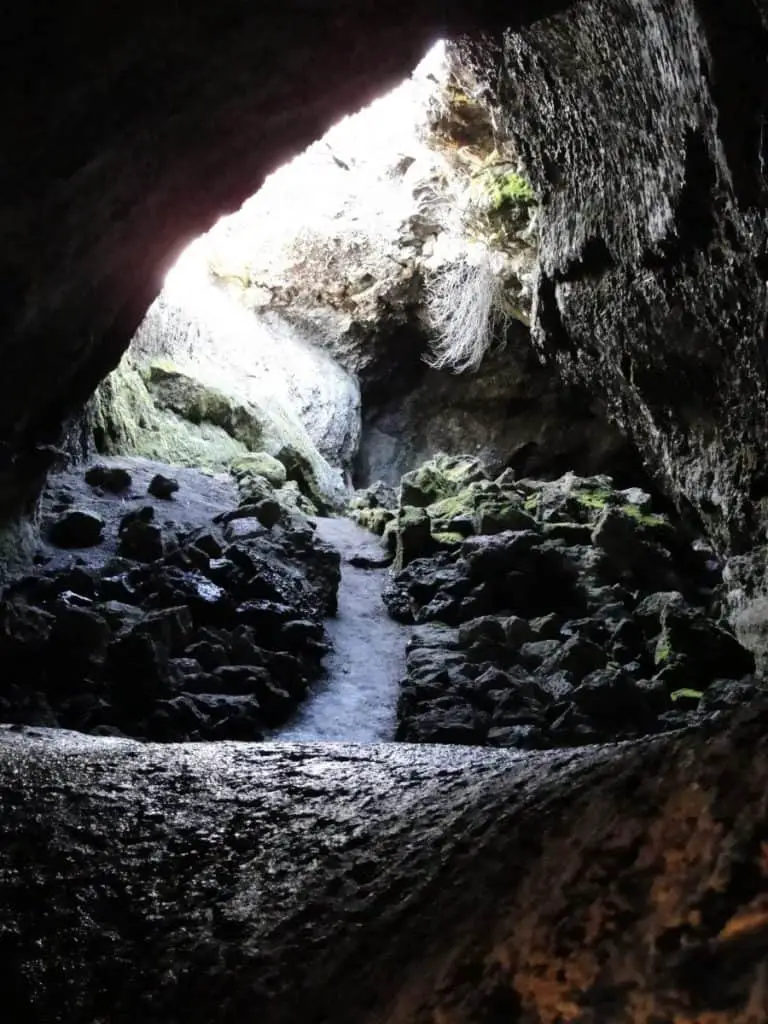
How Long Does It Take for a Cave to Form?
Caves take thousands, or in some cases, millions of years to form. Geologists talk about time in large chunks – a thousand years is a small amount in the big scheme of things. In the case of caves, a “quick” forming limestone cave might take 50,000 years to form. The average cave takes 100,000 years or so. Some caves take millions of years to be created.
Two factors can influence how long it takes most caves to form. These are:
- The hardness of the rock
- The amount of given rainfall in the area
Not all caves are made of limestone – some are made of gypsum or even hard rock like granite. So, if a cave is being formed in harder rock, it will take longer for the water and acid to erode the rock away. Softer rock like limestone and gypsum takes a shorter amount of time.
The amount of rainfall is also important. Water is a key ingredient for creating most caves. If there is a lack of water, then there is less dissolving action taking place. It will take longer to dissolve the rock.
Caves that are formed by other means, such as wind, sand, or ice, can be created much faster. As you can imagine, these types of caves might have very different timelines. When you think about how easily ice can melt, or sand can crumble, you get an idea of how fragile these caves can be.
Formations in Caves
Inside a cave, changes are constantly occurring. These changes take thousands or even millions of years. Because caves are typically created by groundwater seeping through rock, caves tend to be moist, dark places. The reactions between acidic water and limestone can produce a variety of formations.
Speleothems
All cave formations are called speleothems. The word “speleothem” comes from the Greek “spelaion” meaning cave and “thema” which means deposit. It makes sense – over time, water and rock mix and deposits themselves on the walls, floor, and ceiling of the cave. The most common speleothems are:
- Stalactites
- Stalagmites
- Cave Pearls
These intricate formations are the main draw for many cave visitors, who are captivated by their bizarre, otherworldly appearance.
Stalactites
These form when water drips from the ceiling. The acidic, limestone-rich water slowly creates a sort of icicle-shaped formation which can grow to be quite long. To picture what stalactites look like, imagine bumpy, rocky icicles hanging from a cave ceiling.
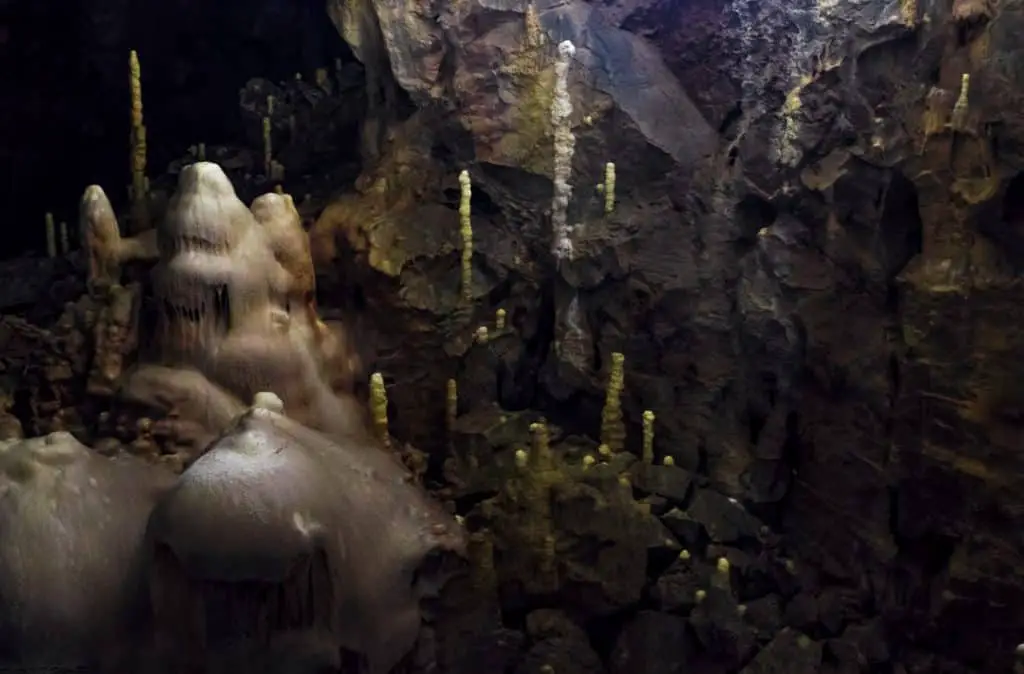
Stalagmites
This type of formation begins on the ground. Water drops from stalactites hanging from the ceiling, puddling on the ground and evaporating. The minerals left behind begin to accumulate into a sort of pile. Over many years, the pile grows larger, and may eventually connect to the stalactite overhead!
Stalagmites can look like globs of goo that have melted together to form mounds. They can also resemble broomsticks, or even totem poles.
It can be difficult to remember which-is-which when it comes to stalactites and stalagmites. A helpful tip is to remember stalactites resemble icicles, and both the word stalactite and icicle have the letter “c” in them. Stalagmite, on the other hand, does not. So just remember, stalactites come from the ceiling and resemble icicles.
It can take millions of years to form large speleothems. In fact, the average growth rate for a stalactite is ½ an inch per every 100 years. Over time, if the stalagmite and stalactite join together, they form a column. Well-formed speleothems bring many visitors to caves, who gather in order to gawk at the beautiful formations.
Cave Pearls
These are another, less common speleothem. They feature a distinctive, luminescent appearance. As the name suggests, these sphere-shaped formations resemble pearls.
Cave pearls are formed when mineral-rich water sticks onto a small particle, such as a grain of sand. Over time, the water evaporates, leaving behind a milky film. More water coats the pearl and evaporates. This continues until many layers are formed, and a “pearl” begins to take shape.
Cave pearls can be found in many sizes. Most are small, less than half an inch across. Larger pearls can be over 8 inches in diameter. The Son Doong cave in Vietnam boasts some of the world’s largest cave pearls, said to resemble baseballs.
Extreme Caves
Caves are fascinating places for many reasons. Some are popular tourist destinations offering up-close, family-friendly excursions to caverns filled with glowing stalactite and stalagmite formations. But there is another type of cave not suitable for all ages. In fact, only experts may apply. These extreme caves attract thrill-seekers, scientists and explorers hoping to be the first to step foot on newly discovered land. Here are just a handful of some of the most extreme caves on Earth:
Son Doong Cave, Vietnam
Famous for: being the largest cave (by volume) on Earth
The Son Doong Cave is a solutional cave found on the Laos-Vietnam border. Dubbed the “mountain river cave” by locals, just traveling there requires a 12-mile journey through humid jungles and foliage-covered mountains. Once there, adventurers must don lighted helmets as the journey to the main cavern is in complete darkness.
Those brave enough to do so are rewarded with an incredible sight – the main cavern. It is lit by the sun and features unique rock formations covered in lush foliage.
The scale of the huge interior of the Son Doong cave is mind-boggling – an entire New York City block would fit inside the cave walls, skyscrapers and all. Here is an epic YouTube video that captures the journey through the Son Doong cave so you can visit from the comfort of your couch!
Eisriesenwelt Cave, Austria
Famous for: being the largest ice cave in the world
The Eisriesenwelt Cave is an ice cave that measures an impressive 26 miles long. The word “eisriesenwelt” means “world of the ice giants” in German, and it’s easy to see why people might have imagined this cave as a dwelling for giants. The otherworldly cavern was formed by thawing snow passing through a rock cave and freezing into ice during the winter. Unlike a glacier cave, which is formed completely by ice, this cave was made by water freezing to an existing rocky cave.
The Eisriesenwelt Cave has been developed into a tourist destination, so if an adventure is on your bucket list, this is one of the tamest “extreme” caves to visit. A word of caution – extreme HEIGHTS are involved, so if you have a fear of looking down, steer clear of this cave.
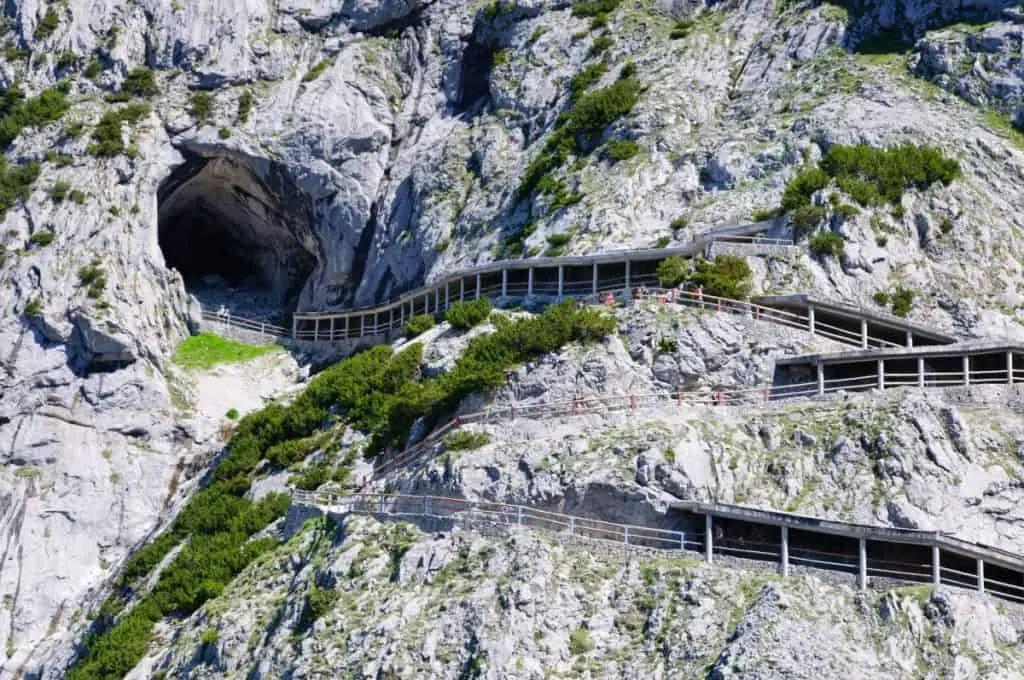
Veryovkina Cave, country of Georgia
Famous for: being the deepest cave in the world
The Veryovkina Cave is located in rocky, arid land where the continents of Europe and Asia meet. This area is home to 4 of the deepest caves in the world. This is due to the abundance of soft limestone and a steady supply of rain – the perfect recipe for a solutional cave.
The Veryovkina cave measures in at a whopping 7,257 feet deep – that’s almost a mile and a half underground. It took over 50 years for scientists to discover its depth. Some explorers think there still might be more to discover.
Don’t plan a family trip to this cave, however. Visiting the Veryovkina cave is for experienced explorers only. Think of it as the Mt. Everest of spelunking (cave exploration). In fact, it takes six days to complete the journey round-trip – three days to climb down, and three to climb back to the surface. Claustrophobes need not apply! Check out this video for a virtual tour and more information about the discovery of the Veryovkina.
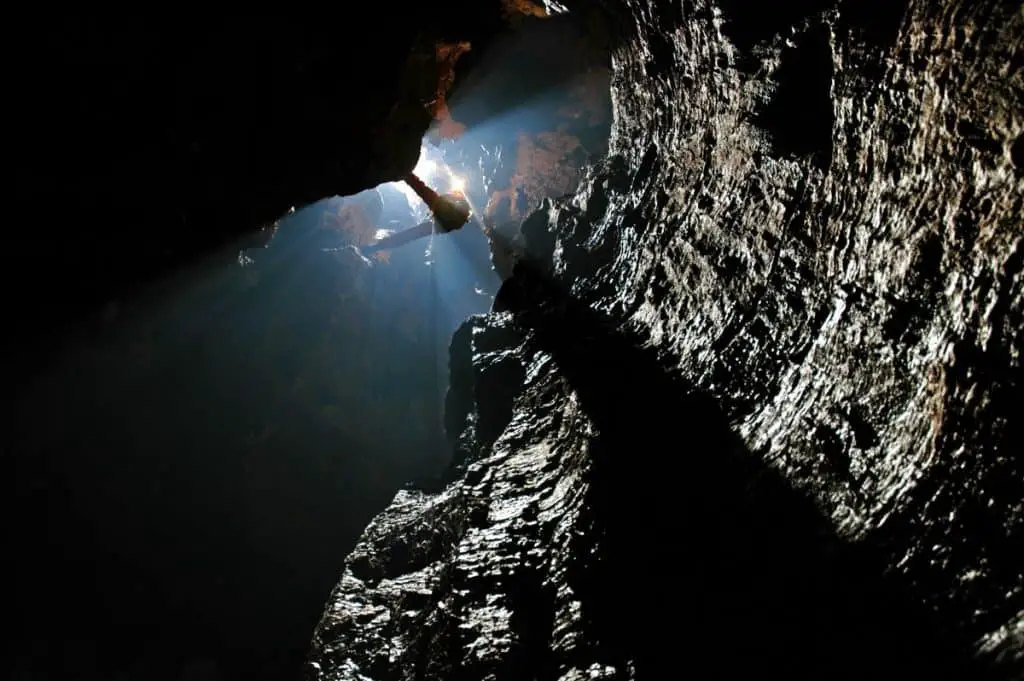
Caves for the Whole Family
If daredevil adventures aren’t on your list, or if you have young children in tow, a trip to one of these popular tourist destination caves might be more your speed. Caves continue to fascinate young and old alike with their otherworldly rock formations, dimly lit interior, and occasional spooky bats in residence. These caves deliver on all of that, and more.
Mammoth Cave National Park, Kentucky, USA
Famous for: being the longest cave system on Earth.
When you think caves, I bet Kentucky isn’t the first place that pops into your mind. Yet, Kentucky can lay claim to housing the longest cave system in the world. Welcoming millions of visitors each year, this National Park is a family favorite. 400 miles of tunnels have been explored thus far, and scientists believe there may be another 600 miles yet to discover!
Visitors to Mammoth Cave National Park don lighted helmets and walk, crawl, and hike through guided paths within the cave system. Wildlife abounds, including the classic cave-dwelling bat. Explorers may also be lucky enough to spot the Eyeless Cave Fish, a rare creature that has adapted to the darkness by no longer growing eyes.

Waitomo Caves, New Zealand
Famous for: being home to the unique Waitomo glowworms
Known to the local Maori people for generations, European descendants only discovered these caves in the late 1800s. Looking up from a boat within the dark interior of the caves, explorers were amazed to see glowing creatures dotting the ceiling. These oddities were glowworms – and they wowed the new visitors. The Waitomo Caves have been a popular destination ever since.
Visitors today can choose from a variety of tours. They can hop into a boat, walk-in on foot, or even catch a ride in a gondola. Close-up visits with glowworms are a must. As with any worthwhile tourist attraction, photo ops abound for the whole family.
Exploring Caves
Caving, also known as spelunking, is a popular sport. Spelunking has a reputation – some say unfairly – for being an extreme sport. Most cavers would agree that if you follow proper safety precautions, caving is actually quite safe. However, the challenges of dark caverns, slippery surfaces, and falling rocks would put caving into the “extreme” category for many people.
There are some basic routines that cavers follow each time they descend into a cave. Anyone considering a trip to a cavern (aside from a guided tour through a heavily trafficked one) should take precautions, pack a bag, and prepare themselves properly.
Here’s a recommended list of clothing and equipment:
- Headwear – a hard hat is often worn to protect the caver’s head from rough walls and ceilings, as well as falling rocks.
- Lighting – an LED headlamp mounted onto the helmet is a popular choice to provide illumination in dark cave passageways, while keeping the hands free to maneuver.
- Clothing appropriate to the cave environment – this could mean warm clothing in a cool cave, or light clothing in a humid, hot cave. Thick material might be required to avoid clothing being torn on rough floors and walls.
- Protective footwear with good traction for slippery surfaces – typically this will mean a pair of ankle-high boots, waterproof if the cave floor is wet.
- Knee pads and elbow pads – these are helpful for crawling and scrambling over rocks. Pads will save you from painfully skinned knees and elbows.
- Gloves – another must-have, gloves protect your hands as you navigate rough ground.
For more information on equipment be sure to check out my recommended gear section.
You may need to pack additional, specialized gear depending on the terrain in the cave. For example, if it will be necessary to scale rock walls, you will need to bring rock climbing gear such as:
- Ropes
- Bolts
- Slings
- Carabiners
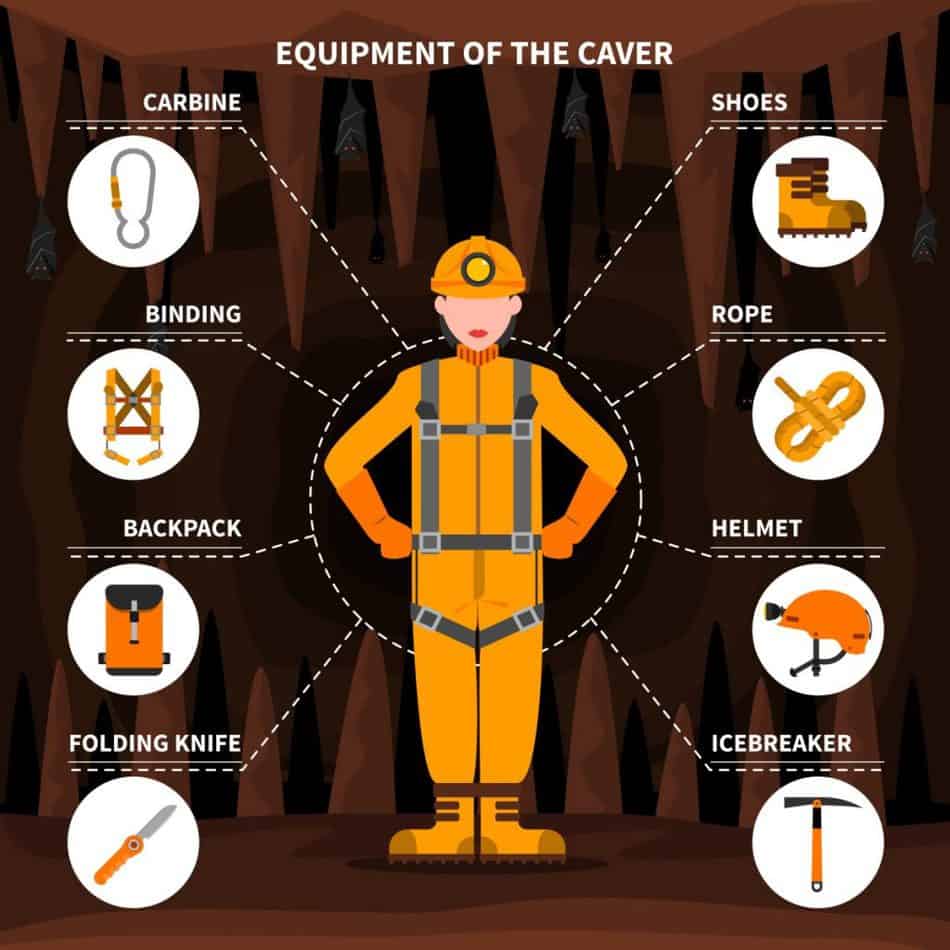
While not all caves require rock climbing skills, it is important to plan ahead and learn about the cave you will be visiting ahead of time. If you would like to learn more about rock climbing and the gear you need, the U.S. Forest Service provides further details on climbing gear for those looking to explore and climb within caves.
Protecting Caves
As with any visit to nature, it is important to be a responsible custodian of Earth’s beauty. There are a few key rules when visiting caves, which are:
- Take nothing but pictures – you might see nothing wrong with grabbing a rock from a riverbank or picking a pretty wildflower, but imagine a million people a year doing the same thing. Humans tend to leave damage in their wake (graffiti, carving initials into tree trunks, etc.) but cavers remind us to leave everything as we found it. Future generations will thank us!
- Leave nothing but footprints – similar to the first rule, don’t leave stuff behind either! Pack out your trash, stay on the trail and definitely do not paint anything. If you brought it in, bring it out.
- Kill nothing but time – being a good steward of our planet includes caring for the animals and insects we might encounter within a cave.
When speaking specifically about caves it is important to note that bringing outside contaminants into a delicate ecosystem can have disastrous effects. Some caves, like Mammoth Caves National Park in Kentucky, even require visitors to use special bio-cleaning shoe mats upon exiting the cave to prevent possible contaminants from spreading. It is good to be mindful of what you bring into – and out of – a cave.
Cave Ecosystems
You may be wondering what sorts of plants and animals can survive in a place that gets no sunlight? Cave ecosystems are extremely diverse, and just like their counterparts in forests and mountains, they rely on a complex network of creatures which feed upon one another.
In caves without sunlight, plants and animals have to get their energy from other sources. The source? Water. Caves are abundant with water, although it might not look tasty to you and me. Water in caves is rich in minerals and nutrients that tiny organisms can feed on. In turn, larger creatures eat the ones before them, and so on.
Cave Creatures
So, what kinds of animals can live in caves? Lacking sunlight, caves are home to some pretty unique and hardy animals.
- Cave Harvestman – this critter looks like a spider, but is actually a special type of arachnid all its own. It is one of the more common – and creepy – creatures within caves.
- Pseudoscorpion – also called the false scorpion, it is so tiny you probably wouldn’t notice it.
- Cave Crayfish – it looks just like a regular crayfish except for its eerie white coloration. The cave crayfish’s claim to fame is that it can live an incredibly long time – up to 175 years!
- Kentucky Cave Shrimp – with Kentucky being home to some amazing caves, it’s no surprise there are creatures named after the state. These pale white shrimp have evolved over millions of years in darkness to no longer need eyes.
- Cave Beetle – this little guy likes to feed off of decaying plants and animals.
- Texas Blind Salamander – at 6 inches long, this salamander has an appearance that could be confused for a baby dragon.
- Mexican Tetra – this is a fish that has evolved in the darkness to no longer need eyes. Aside from that, it looks like any other fish.
These creatures have spent millions of years evolving adaptations which allow them to thrive in complete darkness. When you visit a cave you just might run into some of these rare insects and animals.
Visiting Caves
Hopefully learning about the different types of caves, their features, and the creatures that inhabit them has inspired you to get out and explore. Whether you plan on visiting a cave designed for the whole family to enjoy, or you’re ticking a box on your bucket list and adventuring into a more difficult cavern, there is much to be seen. Remember the three rules of caving:
- Take nothing but pictures
- Leave nothing but footprints
- Kill nothing but time
You’ll also want to pack appropriately and wear the right type of clothing for the terrain. Don’t forget your camera, and keep an eye out for some of the unique cave-dwelling creatures lurking in the shadows. A cave visit will no doubt be a memorable adventure!
When you’re ready to get started caving, be sure to read my Beginners Guide and check out my recommended gear section.

